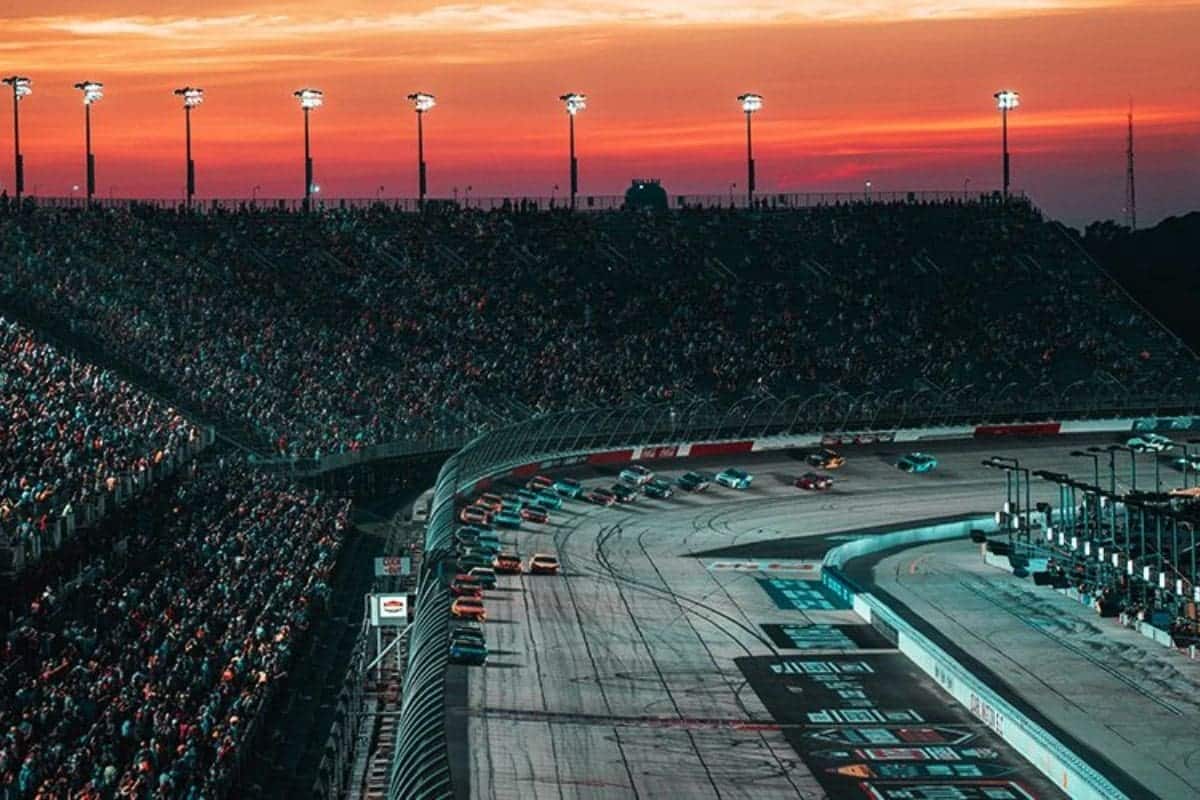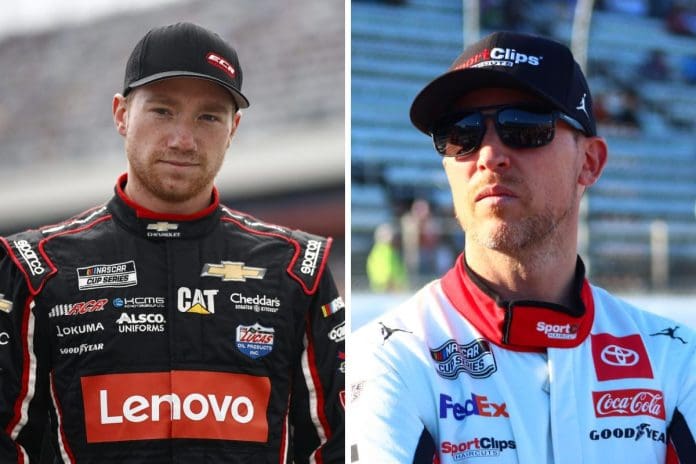NASCAR’s Toughest Oval Track: In NASCAR, Darlington Raceway emerges as a formidable contender for the title of the toughest oval track, a sentiment echoed by seasoned drivers Denny Hamlin and Tyler Reddick. Their experiences highlight the raceway’s notorious reputation, stemming from its asymmetrical egg-shaped design and the unforgiving, sandpaper-like surface that aggressively wears tires. The intricate challenges of Darlington, particularly the treacherous Turns 3 and 4, not only demand technical skills but also push the strategic limits of teams and drivers. As we consider the upcoming races, all these veteran drivers will navigate the complexities of ‘The Lady in Black’ under the changing dynamics of NASCAR competition.
Key Takeaways
- Darlington Raceway is recognized as NASCAR’s toughest oval due to its unique, egg-shaped layout and abrasive surface.
- Both Tyler Reddick and Denny Hamlin emphasize the track’s complexity and the precision required in navigating turns, especially turns three and four.
- The track’s notorious ‘Darlington Stripe’ in Turn 2 exemplifies the precision and mental toughness needed to compete effectively.
- High tire wear and strategic pit stops are critical for success at Darlington, challenging drivers to balance speed with tire conservation.
- Mastery at Darlington demands not only physical skill and focus but also exceptional mental resilience and strategic planning.
Darlington Raceway: NASCAR’s Toughest Oval
Renowned among NASCAR Cup Series drivers, Darlington Raceway, often referred to as ‘The Lady In Black,’ represents the pinnacle of challenge with its unique 1.3-mile oval track that rigorously tests drivers’ skills and resilience. This reputation is not unwarranted, as the track’s layout and surface present a multifaceted test that demands strategic insight and exceptional driving ability.
The track’s distinctive egg-shaped design, with one end tighter than the other, mandates that drivers adapt their racing lines and speeds differently in different segments of the circuit. This irregular configuration is a result of the track’s development history, where the need to preserve a minnow pond adjacent to the property influenced the track shape. The result is a racing environment where mastering one turn does not necessarily translate to success in another, pushing drivers to continuously adjust and react.
Moreover, Darlington’s surface is famously abrasive, contributing to higher tire wear compared to other tracks. This characteristic intensifies the challenge as managing tire degradation becomes vital to maintaining speed throughout a race. Drivers and teams are often forced to balance aggression with conservation, making strategic pit stops essential in their race tactics.
The track’s narrow racing groove further complicates overtaking attempts, raising the stakes of each try to pass. It’s this combination of harsh track conditions and the constant demand for adaptability that rightfully earns Darlington the title of NASCAR’s toughest oval. Here, mere speed is secondary to endurance and strategic depth, attributes that define the legends of the sport.

Tyler Reddick’s Perspective on Darlington
In a pre-race interview in Kansas, Tyler Reddick elaborated on the complexities of Darlington Raceway, highlighting the perilous task of maintaining proximity to the wall on each lap and the particularly challenging design of turns three and four. He noted that the historical track, often referred to as ‘The Lady in Black,’ demands a high level of technical skill and mental resilience from drivers. The track’s worn surface and the abrasive nature of the asphalt compound the difficulty, affecting tire wear and vehicle handling unpredictably throughout a race.
“It’s just so easy to get yourself in the wall anywhere around the racetrack,” he quipped. “With the shape and your approach you have to turn into those corners. You kind of have to thread the needle by the wall every lap to have a good arc.” Reddick
Reddick described the mental acrobatics required to execute a perfect lap at Darlington. Each corner of the track, according to him, presents a unique challenge that can vary significantly with even minor changes in track temperature or car setup. He emphasized the importance of precision in throttle control and steering to avoid the infamous Darlington stripe, a mark left on cars that scrape against the wall. This, Reddick pointed out, is a reflection of just how narrow the margin for error is on this historic oval.
“And then just how turn three and four is shaped, [how] the wall is shaped, it’s a bit wavy.”
“So if you get on the corner chasing the wall you’re going to end up hitting it about a third away.” Reddick
Furthermore, Reddick analyzed how the asymmetrical layout of turns three and four requires a shift in racing lines and braking points, unlike more symmetrical tracks where a consistent rhythm can be more easily established. The complexity is magnified, he explained, by the psychological demands to maintain speed while literally racing inches from disaster.

Denny Hamlin’s Experience at Darlington
Denny Hamlin, a seasoned NASCAR driver and team founder, identifies Darlington Raceway as one of the most demanding tracks, where constant vigilance is crucial due to its variable grip levels and the critical need to navigate close to the walls without error. Hamlin’s perspective on Darlington highlights the precision required to master the track, emphasizing that even minor lapses can lead to significant consequences.
Hamlin’s experience highlights the unique challenges presented by Darlington’s asymmetric layout. The track’s notorious turns, particularly the tighter radius of Turns 3 and 4 compared to Turns 1 and 2, necessitate a highly adaptive driving style. This asymmetry not only tests a driver’s skill but also their ability to anticipate and react to the car’s changing dynamics throughout the race.
“All those things are just really difficult to wrap your head around and why it takes guys sometimes a long time to get good there.” Hamlin
Through his experiences, Hamlin has developed a deep understanding of how to utilize these factors to his advantage, constantly refining his strategies to align with the evolving conditions of the race. His analytical approach to racing at Darlington serves as a masterclass for all his peers and the newcomers in the sport, showing the level of mastery required to succeed on NASCAR’s toughest oval track.
The Challenge of Racing at Darlington
Often described as NASCAR’s ultimate test of skill and endurance, Darlington Raceway demands exceptional precision and adaptability from every driver who challenges its unique egg-shaped oval. Known as ‘The Lady in Black,’ this track is notorious for its relentless wear on tires and driver focus, due to its asymmetrical layout and the notorious turns that require near-perfect execution.
Moreover, the necessity of racing close to the wall, famously resulting in the ‘Darlington Stripe’ as cars scrape against it, pushes precision driving to its limits. The track’s narrow racing groove leaves little room for error, and the abrasive surface aggressively wears down tires, complicating pit strategy and demanding peak physical condition and concentration from drivers.

Looking Ahead to Darlington Raceway
As the NASCAR season progresses, focus shifts to the upcoming race at Darlington Raceway, presenting a formidable challenge to even the most seasoned drivers. Known as ‘The Lady in Black’, Darlington demands exceptional skills and precision, characteristics that are tested thoroughly on its distinctively abrasive surface and treacherous turns. This track, steeped in history, not only challenges drivers with its physical layout but also tests their strategic expertise, as tire management becomes vital in maneuvering the race successfully.
Advanced preparation for Darlington is indispensable. Teams spend countless hours analyzing previous races and adjusting their strategies accordingly. The high tire wear due to the track’s rough surface requires a detailed approach to tire strategy, often making or breaking a race outcome. Drivers must balance aggression with conservation, pushing their cars to the limit while ensuring they have enough grip to finish the race strongly.
News in Brief: NASCAR’s Toughest Oval Track
Darlington Raceway represents the peak of NASCAR’s racing challenges. Its distinctive egg-shaped contour, abrasive surface, and the notorious ‘Darlington Stripe’ demand technical skill and strategic depth from participants.
As demonstrated by the experiences of seasoned drivers like Denny Hamlin and Tyler Reddick, this track not only tests physical endurance and precision but also highlights the mental resilience required to excel in motorsports, thereby affirming its status as one of the most formidable circuits in NASCAR.
ALSO READ: Richard Petty Favors New NASCAR Tracks for Surprising Reason

